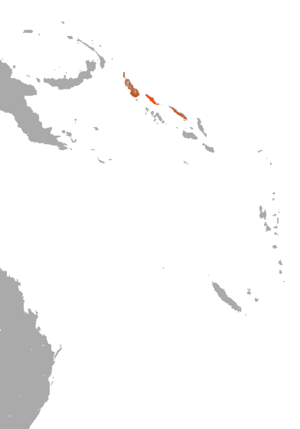Greater monkey-faced bat facts for kids
Quick facts for kids Greater monkey-faced bat |
|
|---|---|
| Conservation status | |
| Scientific classification | |
| Genus: |
Pteralopex
|
| Species: |
flanneryi
|
 |
|
| Greater monkey-faced bat range | |
The greater monkey-faced bat (Pteralopex flanneryi) is a large bat that lives only on the Solomon Islands and Bougainville in Papua New Guinea, plus some smaller islands nearby. It's also called the greater flying monkey because of its face. Sadly, this amazing creature is critically endangered, which means its numbers are dropping fast. It's the biggest of all the monkey-faced bats.
About Its Name
Before 2005, people thought this bat was the same as another type, the Bougainville monkey-faced bat. But in 2005, a scientist named Kristofer Helgen described it as a brand new species. He named it flanneryi to honor Dr. Tim Flannery, who studied mammals in a region called Melanesia. Scientists think its closest relative might be the Guadalcanal monkey-faced bat.
What It Looks Like
This bat is the largest in its group. Its forearm (part of its wing) is about 15.9 to 16.9 centimeters (6.3 to 6.7 inches) long. Its wings can spread out to more than 1.5 meters (5 feet)! It weighs around 790 grams (1.7 pounds).
Its fur is short and black, sometimes with white or yellow tips on its chest. Unlike the Bougainville monkey-faced bat, which lives in the same area, the greater monkey-faced bat doesn't have a big white or yellow patch on its chest. It has a special "double canine tooth" and strong jaws. Scientists think these might help it break open tough coconuts!
Life and Habits
Because this bat is so rare, we don't know much about its daily life. Scientists once found a mother bat feeding her baby in July. Young bats have also been seen in February, April, and September.
It's believed that these bats mainly eat fruit, which means they are frugivores. They have even been seen eating unripe coconuts.
Where It Lives
The greater monkey-faced bat lives in lowland forests, usually at elevations from sea level up to 200 meters (656 feet). It needs old, untouched forests to survive. You can find it on several islands in Papua New Guinea and the Solomon Islands. These include Bougainville Island, Puruata Island, Buka Island, Choiseul Island, Santa Isabel Island, and Barora Fa Island.
Protecting This Bat
The International Union for Conservation of Nature (IUCN) lists the greater monkey-faced bat as critically endangered. This means it's at a very high risk of disappearing forever. The main threats to this bat are hunting (sometimes for food) and its forest home being destroyed. Since 1990, only one of these bats has been officially seen!
Some of the islands where it lives are also at risk from climate change, which could harm the species even more. In 2013, Bat Conservation International put this bat on its list of 35 top priority species to protect worldwide.
Many groups are working hard to save these bats. Bat Conservation International is working with the local Rotokas people, Volunteer Service Abroad, and the Bougainville Bureau for the Environment. Together, they are creating a plan to protect an important area called the Kunua Plains & Mount Balbi Key Biodiversity Area. This plan aims to help both the greater monkey-faced bat and the Bougainville monkey-faced bat.
Some of the things they are doing include:
- Helping local people find other food sources so they don't have to hunt bats.
- Planting new native trees to help forests grow back.
- Finding ways to stop bats from eating farmers' crops, so farmers don't get upset with the bats.
- Talking more with local communities about why conservation is important.
Researchers who want to study bats in the Kunua Plains & Mount Balbi area also pay the Rotokas people to access their land. They hire local guides and porters and buy food from local villages. This helps provide income for the Rotokas people while protecting the bats.


